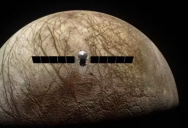NASA’s Upcoming Mission To Jupiter’s Moon Europa Now Has The Ability To Detect Life

NASA has been working on a spacecraft custom built to study Jupiter’s moon Europa for several years now. The Europa Clipper is the largest craft built specifically for this type of mission in NASA’s history, and it is almost ready for launch.
With the expected launch being in October of 2024, scientists and engineers are putting on the finishing touches to ensure everything goes well.
In one of these final tests, however, they found something very interesting and exciting.
One of the nine instruments onboard called the Surface Dust Mass Analyzer (SUDA) has an ability that was not fully expected.
The ability to detect alien life.

This instrument was designed to collect dust that was ejected from the moon and analyze it for the building blocks of life (carbon, oxygen, sulphur, phosphorus, etc).
When scientists from the University of Washington tested their ionizing mass spectrometer (the same type of instrument as will be used on this mission), they were able to detect the presence of bacterial material.
More impressively, they could detect it when even just 1% of a cell’s overall material was present in the ice grains that were collected.
These tests were done in an environment designed to simulate what the Europa Clipper will experience.
This means that in addition to analyzing Europa for its potential to support life, the mission could now determine if there is, or was, life on the moon.
Murthy Gudipati from NASA’s Jet Propulsion Laboratory made sure to clarify that the point of the mission has not changed despite this finding, saying:
“We are not a life-finding mission. Europa Clipper’s goal is to understand Europa’s ocean and the moon’s habitability.”
Of course, if the mission is able to detect life on Jupiter’s moon, it would be one of the most important findings in human history.
Confirming that life has formed in our solar system, but outside the Earth, even if the life is just microbial, would indicate that life is likely quite abundant throughout the universe.

Fabian Klenner, a researcher on the project, commented:
“If life forms on Europa follow the same principle of having a membrane and DNA made from amino acids … then detecting those chemicals would be a smoking gun for life there.”
While it is certainly very exciting to find that this mission now has the ability to detect life, we won’t be getting answers very soon. The mission should launch in October of 2024, but Jupiter is a long way away and it will take time to collect and analyze the information.
The spacecraft won’t even arrive at Europa until 2030 or beyond, and that is just one step in its exciting mission.
If it is able to detect life, or even just the building blocks of life, future missions will undoubtedly be planned to Europa in the coming decades.
Finding life on Europa would be a game changer for humanity.
If you think that’s impressive, check out this story about a “goldmine” of lithium that was found in the U.S. that could completely change the EV battery game.

Sign up to get our BEST stories of the week straight to your inbox.




